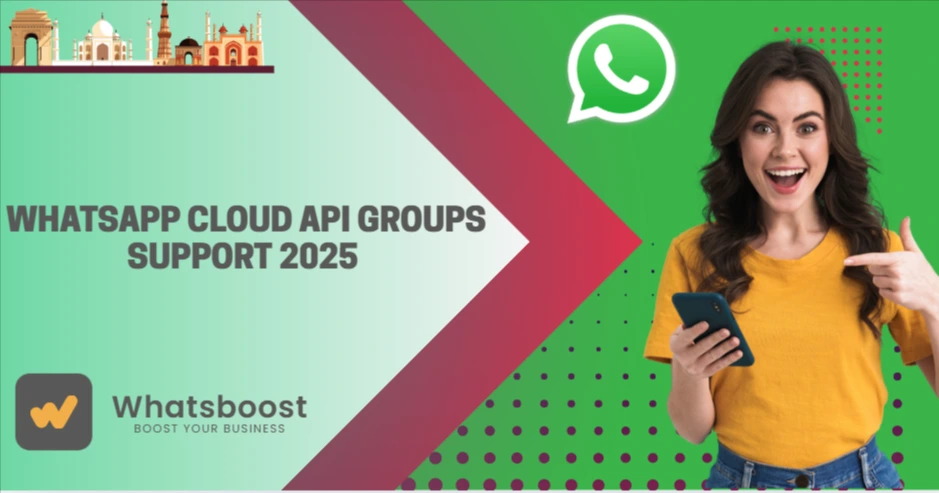
WhatsApp Cloud API Groups Support in 2025: The Complete Business Guide
Learn how to use WhatsApp Cloud API for groups in 2025. Discover setup steps, automation tips, and business use cases to boost collaboration and engagement.
Groups have always been a core part of WhatsApp’s success — from family chats to workplace discussions. For businesses, groups offer a powerful way to nurture communities, run beta programs, and share updates. But here’s the big question: can you manage WhatsApp groups programmatically using the Cloud API in 2025?
This in-depth guide goes beyond surface-level answers. We’ll explain what’s possible with the WhatsApp Cloud API, what limitations still exist, and how businesses can still create workflows that leverage groups effectively — all while staying compliant with Meta’s policies.
1. Understanding WhatsApp Cloud API’s Core Capabilities
Before diving into groups, let’s quickly revisit what the WhatsApp Cloud API actually offers in 2025:
-
Conversation Management: Send and receive messages at scale with customer opt-in.
-
Rich Media Support: Share images, videos, documents, and interactive buttons.
-
Webhooks: Get notified in real time about message status, user replies, and events.
-
Template Messages: Send proactive notifications within Meta-approved categories.
-
Integrations: Connect with CRMs, e-commerce stores, and workflow tools.
These capabilities make the Cloud API ideal for sales, support, and notifications — but group management is still limited, as we’ll explore next.
2. The State of Group Support in 2025
As of 2025, the WhatsApp Cloud API does not support full programmatic group management — meaning you cannot:
-
Automatically create new groups.
-
Add or remove participants programmatically.
-
Change group settings (name, description, admins) via API.
However, there are several actions that are possible:
-
Send messages to existing groups where your business number is already a participant.
-
Listen to group messages using webhooks, allowing your system to react to group events.
-
Share group invite links to onboard new users manually.
This partial support means businesses can still use groups strategically — they just need to combine API automation with manual group setup or participant management.
3. Why Groups Still Matter for Businesses
Despite these limitations, groups remain an important business tool:
-
Customer Communities: Ideal for product enthusiasts or loyalty program members.
-
VIP or Beta Tester Groups: Get instant feedback from power users.
-
Support Hubs: Create focused groups for resolving common issues.
-
Internal Communications: Small teams can use groups for project-specific updates.
The key is designing a strategy where groups supplement 1:1 messaging, rather than replace it.
4. Business Use Cases with Hybrid Workflows
Let’s look at practical ways to use WhatsApp Cloud API in combination with groups:
A. Group Trigger → 1:1 Follow-Up
-
How it works: Your webhook detects a keyword or question posted in a group.
-
Automation: The API sends a private message to that user, offering assistance or sharing a resource.
-
Use case: Customer asks about pricing → automation sends them a product catalog privately.
B. Group Invite Sharing
-
Generate group invite links.
-
Use approved template messages to share those links with opted-in users.
-
Perfect for onboarding new customers into interest-based communities.
C. CRM + Group Insights
-
Capture group participants into your CRM (with consent).
-
Track engagement and send targeted broadcasts to active members.
D. Broadcasts for Announcements
-
Instead of relying on groups for mass updates, use broadcasts via the API.
-
Benefits: Messages reach even those who mute groups, and delivery rates are higher.
5. Compliance & Policy Considerations
Meta has clear policies to prevent spam and misuse:
-
User Consent: Only send messages to users who have explicitly opted in.
-
Approved Templates: All proactive notifications must use Meta-approved templates.
-
Avoid Spam: Adding users to groups without consent can result in account restrictions.
-
Data Privacy: Store participant data securely and comply with GDPR/DPDP regulations.
Businesses must regularly review Meta’s official developer documentation to stay compliant.
6. Common Mistakes to Avoid
-
Over-relying on groups for marketing: Groups are better for community engagement, not for cold outreach.
-
Ignoring opt-in: Users who are added without consent may report or block the number.
-
Not monitoring group health: Dormant or spammy groups hurt brand perception.
-
Failing to combine with 1:1 automation: Missing the chance to personalize and convert leads.
7. Preparing for the Future
Meta frequently updates the Cloud API with new capabilities. While full group management isn’t supported yet, businesses can prepare by:
-
Keeping group participant data organized in a CRM.
-
Designing workflows that can adapt quickly if group automation is released.
-
Subscribing to update feeds from Meta and Whatsboost’s resource hub.
This preparation ensures that when group APIs are eventually released, you can implement them faster than competitors.
8. Best Practices for Success
To get the most from groups + Cloud API workflows:
-
Segment Your Groups: Create smaller, topic-specific groups instead of one large, noisy group.
-
Set Clear Rules: Pin group guidelines to maintain quality discussions.
-
Use Automation Wisely: Trigger private follow-ups instead of spamming the entire group.
-
Monitor Engagement: Remove inactive members periodically.
-
Combine with Other Channels: Email, SMS, and WhatsApp 1:1 messaging should work together.
Conclusion
WhatsApp Cloud API may not yet offer full-fledged group management, but it gives businesses enough tools to build meaningful, semi-automated group strategies. By combining webhook triggers, 1:1 follow-ups, and careful compliance, you can create a workflow that drives engagement and conversions — without risking bans or violating policies.
Businesses that master this hybrid approach in 2025 will be better positioned when Meta eventually expands group API features.
Ready to implement these workflows? Book a Whatsboost demo and see how our automation builder helps you make the most of WhatsApp — groups included.
